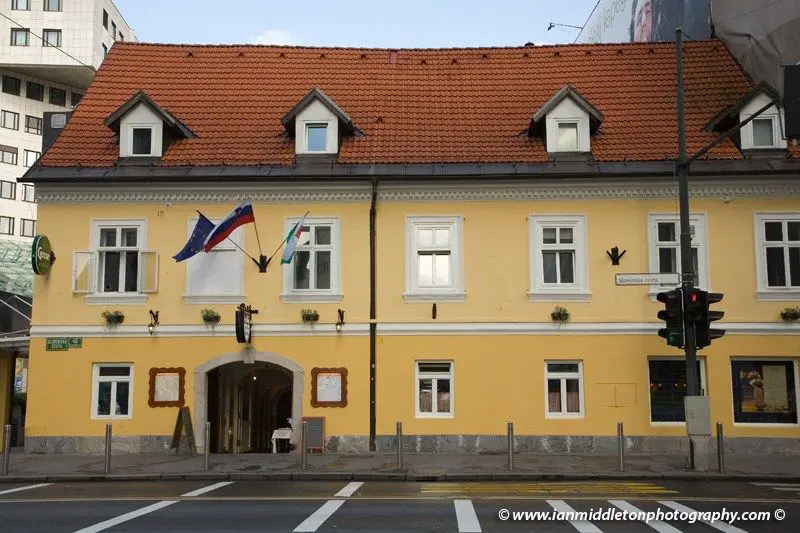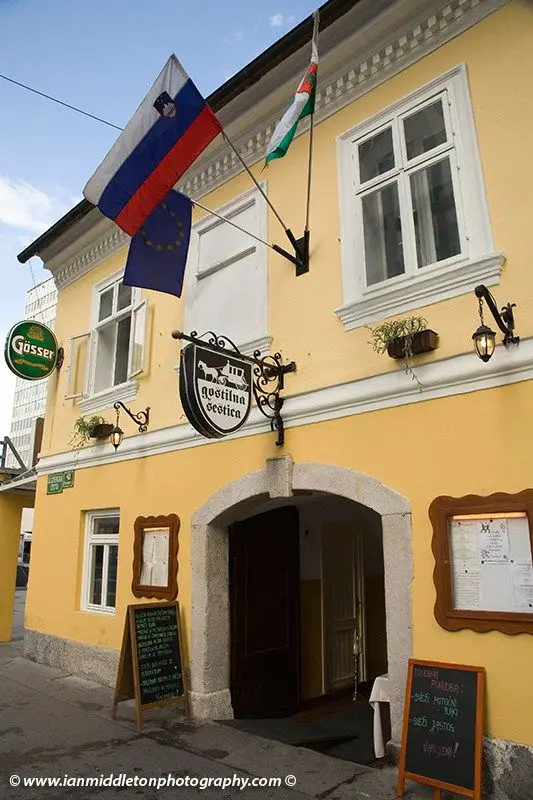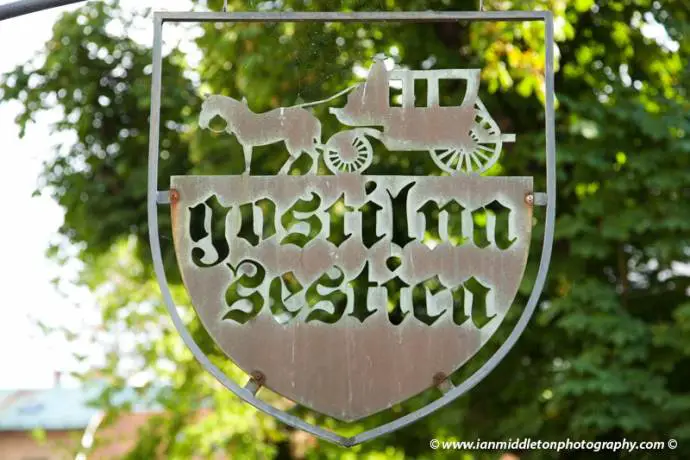January 12. 2018
The old man was sitting proudly across the table from me, his silver hair glistening in the sunlight. The twinkle in his eyes and self-satisfied smile on his face beheld the look of someone who had rekindled an old, long-lost love affair at a time in his life when he’d almost given up hope. Janez Gašperin drew deeply upon his cigarette, and then began to tell me his story.
On Slovenska Cesta, in the heart of Ljubljana, sits Gostilna Šestica, a quiet, unassuming building that for many years was just another dilapidated relic of old Ljubljana; her story having faded away along with her pale and crumbling facade.

For almost two centuries Šestica was the centre of attention, her vivid and youthful exterior attracting people from all across Slovenia and the rest of Europe. Stagecoaches filled the street outside as their owners dined on great food and downed tankards of local beer or sipped fine wines from its cellar. Songs were sung under the shade of the mighty horse chestnut trees in the patio area out back. Among these was a tune that was to become immortalised in time and known to all as: Pri Šestici (at No. 6). “The old lady with the young face!” said Janez. “This is what they used to call Šestica.
Gostilna Šestica is the oldest inn still standing in Ljubljana today. The first actual record of the building came in 1670 when Baron Janez Vajkard Valvasor drew the house on one of his maps. Back then it was a thatched farmhouse owned by the Grmekovi family. The building was officially established as a gostilna in 1776, but it’s likely it was also running as one long before that date. The Inn first got its name Šestica in 1805, when the Ljubljana municipality began allocating street names and numbers. Slovenska Cesta back then was part of Dunajska Cesta, and the houses were numbered, thus the inn became known as the 6th (Šestica). In 1877 the street was changed along with the house number, but the name remained.
Throughout history a total of eight families have owned Šestica. Janez’s grandparents, Aleš and Terezija Zalaznik, bought the place in 1922. Up until this time the building had remained in the style of an old farmhouse. Under the ownership of the Zalazniks the inn was renovated and modernised for the first time ever. An extension was built and a much larger patio area created.
In 1924 Aleš died and his wife continued to run Šestica until 1936. Terezija made such a huge success of the inn, selling her famous homemade goulash, that the profits were used to finance more businesses, including the construction of a new apartment building across the road, which has become affectionately known as Goulash Palace.
However, with the start of World War 2 the good years were about to come to an end.
Šestica was passed down to Janez’s mother, Zinca, in 1940 and she ran it for the next two years. By this time though, the war had spread and Zinca was smart enough to know that owning a business during these years could have dire consequences. With the country being invaded on all sides by various factions, each of these would try to demand money and services from the business and if you were to offer your services to one faction, then you were in danger of being shot by one of the other factions. Therefore she calculated that the best option was to rent the inn to another family, let them take the risk, and return when the war was over. A wise woman! Unfortunately though, the communists won and, under the flag of nationalism, began taking properties from the people.
Like many who opposed the communists, Janez’s parents had to flee in 1945 or else be put on trial for treason. They found temporary shelter in the Viktring refugee camp in Austria before escaping to Italy and then heading to Buenos Aires and establishing a Šestica there.
Meanwhile back in Ljubljana the communists had illegally seized Šestica and from 1950 to 1955 the inn was closed to the public and used exclusively by the secret police. In the years that followed Šestica became known as the people’s asset and anyone who tried to lay claim to it would be executed. Proof of the true owners’ identity became lost over time.
Under state ownership Šestica was severely neglected and the old lady’s young face withered through the turbulent years. Throughout all this turmoil, Janez remained in Slovenia even though his parents had escaped, yet he could only stand across the road, watching and lamenting for the place that was stolen from him and his family.
After Slovenia’s independence in 1991, Janez scrutinised the law for two years and then fought a long legal battle in the courts to prove his family’s ownership of Šestica, which by this time was being run by the state-owned Gostinsko Podjetje Vič. By 1995 Janez had won his case, but ownership was only passed to him under the condition that he continues to lease the business to Gostinsko Podjetje Vič for a predetermined time.
On Christmas Eve 2007, while many children slept soundly in their beds waiting for Santa to bring them the present they’ve always wanted, Janez Gašperin had finally received the present he had long dreamed of: reclaiming full control of his legacy.
By this time the years of neglect were showing. The colour had faded from the old lady’s face and the water stains looked like tears of sadness on her cheeks. Janez entered into a partnership with three others and together they drew up plans for a huge refurbishment and restoration project. Finally, after many decades, the old lady has been given a facelift and has regained her youthful complexion.

Entering Gostilna Šestica is like walking through time. The restoration project has remained faithful to the inn’s original appearance and they now offer a diverse mix of traditional Slovene food served alongside more modern international dishes. You have the choice of eating in the main area, a bright, spacious, wood-panelled room with a high stone ceiling and walls lined with photos from the old days. You can also eat in the Prešeren room, an atmospherically lit area dedicated to the great Slovene poet. A variety of illustrations line the walls, each representing a different impression of him; as no one apparently knew exactly what he looked like. If you prefer the great outdoors then dine in the patio area out back under the shady chestnut trees. The inn also boasts many large function rooms for parties or business lunches.
Every Friday evening the inn hosts a Slovenian night where live folk music is played alongside a traditional Slovenian three course meal. Janez hopes to one day re-discover the complete lyrics to Pri Šestici, and once again hear the old lady’s theme song echoing through her spacious interior. And you can even try Terezija’s famous homemade goulash, the dish that built an empire.
Visit the Gostilna Šestica wesbite here for menus, opening times and more.
You can read more of Ian's travel writing here, while his photography site, with details of workshops, prints and a free e-book, can be found here.






